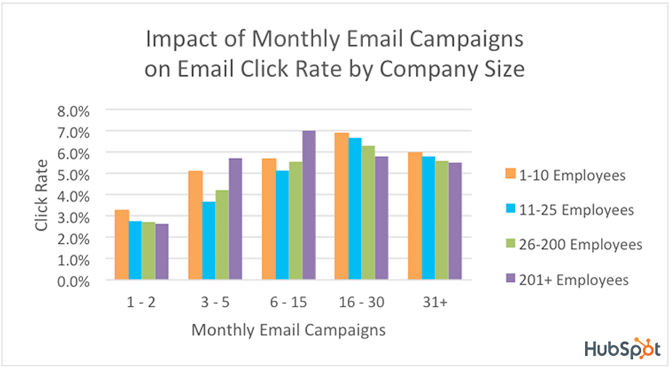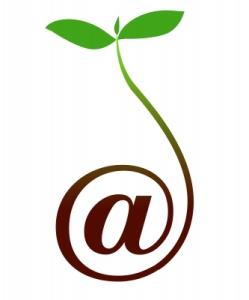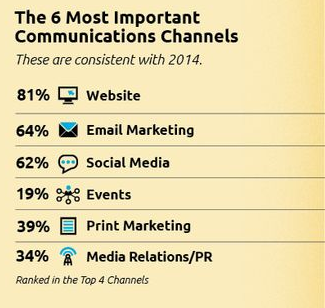As the end of the year approaches, are you planning enough emails?
Emails should be included as part of your robust, multi-channel annual appeal if you want to increase your chances of reaching your goals. On top of that, emails can be a great way to set yourself up for success even before you send an appeal.
Sadly, many nonprofits I encounter are unwilling to email their constituents sufficiently. Here’s what I often hear:
We don’t want to tick them off by mailing too many times.
We can’t ask them for money more than once or twice a year.
They get a lot of mail from us and it’s probably annoying.
They’re probably getting mail from a lot of different departments, so we don’t want to send from our department too often.
What all these comments have in common is that they’re based on a lack of data.
- Most nonprofits haven’t asked their constituents how often they’d like to hear from them.
- They haven’t run A/B tests to see what number of mailings perform best.
- They haven’t even created an integrated, comprehensive internal calendar that enables them to take a realistic look at the number of times their constituents are being mailed to.
It’s almost as if folks are saying “We don’t want to have to do any more work. We’re going to justify being lazy by wrapping ourselves in the noble cloak of being customer-centered and not being a “bother” to our supporters. We’re such good guys, we really are. Far be it from us to be a nuisance to anyone.”
ARRGH!
This is the same logic people use when they don’t want to ask folks for money. And it comes from a place of ignorance and fear.
So… let’s get educated and become courageous.
After all, email (1) is immediate; (2) is relatively inexpensive; (3) yields quick results; (4) gives you new insights into your supporter’s interests and what messaging resonates; (5) is easy to personalize; (6) is easy to segment and test; (7) can include links to pages on your website where readers can take actions (e.g., donating, registering for events, following through on an advocacy action, and more).
What’s not to like?
How Many Email Campaigns Should You Send?
It depends.
You can begin by looking at industry averages. Kivi Leroux Miller’s 2015 Nonprofit Communications Trends Report found the following to be true:
As you can see, email is way up at the top. So if you’re thinking of just sending a snail mail appeal this year, think again.
In an article on Hubspot, Ginny Soskey reports that the sweet spot for email seems to be 16 – 30 campaigns per month, depending on the size of your organization. Companies that send 16 – 30 campaigns a month see a click rate more than 2X greater than the click rate of companies that send 2 or fewer campaigns a month.
If this seems like way too much, know that at this frequency, companies enjoy a median open rate of 32.4% and median click rate of 6.5%. Contrary to what you might assume, it’s the companies with over 201 employees who have a lower optimal mailing frequency. With larger organizations, highest median open rates (32.2%) are found at 3 – 5 monthly email campaigns and highest median click rate (7.0%) is found with 6 – 15 monthly email campaigns.
NOTE: This data is for all businesses, however Mail Chimp reports averages for nonprofits that aren’t too far off the mark: Open Rate 25.12% , Click-through-Rate 3.25% Unsubscribe 0.19%; feel free to use these as benchmarks for your own email strategy).

What does this tell you? Depending on your size, you should adjust the number of email campaigns you send each month. If you’re currently sending less than one/month, you’re in a definite minority. Re-think!
The smaller you are, in general, the more you should communicate.
This makes a kind of intuitive sense, because small to medium-sized nonprofits are often like ‘family’ to their supporters. Family wants ongoing communication or they feel neglected. They want to know what you’re up to! And they want to know that you care about them (and for more than just their money). So your email strategy should involve a variety of calls to action; some asks and even more pieces of news your supporters can use.
Of course, you can’t just rely on industry averages. Your organization may be different. So once you’ve got a ballpark idea based on the research you’ve looked at, it’s time to do some testing of your own.
No guessing; test to find what works for you.
The best way is to run an A/B test. See how here. The key is to only try one variable per test; otherwise you won’t know which one caused the difference in behavior. For email frequency, consider mailing a randomized segment of your mailing list four times/month, for example, while mailing another segment eight times/month. Then see how opens and click-throughs and conversions (i.e., responses to your calls to action such as attending an event, signing a petition, sharing your email, making a donation, etc.) compare.
Don’t just stop with one test, however. Behavior changes over time. So continually test. Perhaps how people respond in December is different than how they respond in July. Find out! And test other variable as well (e.g., subject lines; who the email comes from; graphic images; length of copy and so forth). The more you test, the closer you’ll get to what works best for your constituencies.
The more relevant your messaging, the more often you can email.
One of the reasons nonprofits shy away from emailing too much is that they don’t have a clue what to say if they’re not asking.
It’s easy, really.
Just think about what you’ve got to offer that would be useful to your constituents. Then send them some little gifts (e.g., if you’re in human services, send “Top 10 Ways to Keep Seniors Safe”; in education, send “Your Summer Reading List”; in environment, send “7 Ways to Save the Planet”). Or maybe you’ve got something entertaining or heartwarming that relates to your mission (e.g., links to video outtakes/bloopers from a play rehearsal, stocking a food pantry with wildly misshapen, yet wholly nutritious, veggies; expressions on the faces of kids seeing their first opera; seniors in wheelchairs learning to bowl).
Get creative, and think from your recipient’s perspective.
If your reader will enjoy it, why not email it?
If you need ammunition for your ‘powers that be,’ the 2015 Nonprofit Communications Trends Report found that 45% of nonprofits plan to email an appeal at least monthly (up from 33% last year) and 62% will send an email newsletter at least monthly. Remember, these are averages; there are plenty of nonprofits emailing their supporters weekly or more.
Hint: It’s easier to make your message relevant if you segment your email list. That way you’re sure to send information on the right topics to the right people.
Worry more about too little email than too much.
There really is some truth to the old adage “Out of sight, out of mind.”
Dan Zarrella found, in fact, that frequent is good. In fact, infrequent emails result in more unsubscribes. If a reader is going to unsubscribe, they will likely do it early on. Once your emails are beyond that point, high frequency doesn’t seem to matter — as long as your content is good.
Which brings us back to the heart of the matter. As you approach the end of the year, think about both your year-end and your long-term goals.
Yes, you want to raise as much as you can to meet this year’s goals. You also want to set yourself up to raise even more next year by beginning NOW to instill a desire in your constituents to become more deeply connected with you. It’s your job to make folks want to hear from you. This means wooing folks with appealing communications. As with any relationship, too little is too little.
You’ve got to take the time, and devote the resources, to building supporter relationships.
Email is a fantastic tool. And those who want to hear from you will welcome your email. Those who don’t won’t (no real loss here).
“If less is more, just think how much more “more” will be.” – Frasier













Claire, it’s really important for emails to provide value. If a nonprofit sends too many emails that do not provide value (i.e.- only always asking for a donation), they WILL tick off the supporters on the list. Value-oriented emails should communicate the results the organization and the supporter achieved together with emphasis on the fact that none of it could happen without the supporter. They also should offer the supporter an opportunity to get involved and engage.
Agree 1000% Greg! As I said, the more relevant your messaging, the more often you can email. And I didn’t mean relevant to your organization’s need for money! Abuse the privilege at your peril.